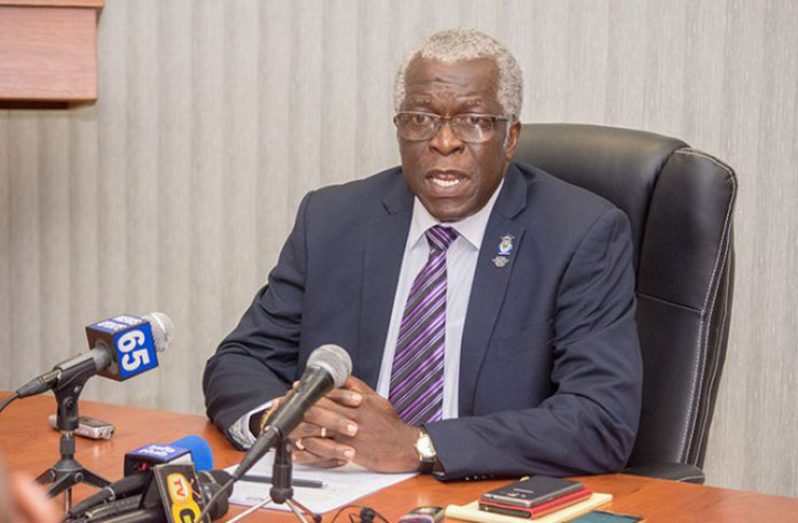— Roraima Airways pilot did 19 shuttle operations on day of death
CAPTAIN Collin Martin, the Roraima Airways pilot who was killed after the Britten-Norman island aircraft he was operating crashed on landing at Eteringbang, in Region Seven (Cuyuni/Mazaruni), had reportedly conducted 19 shuttle operations before his death.
Director-General of the Guyana Civil Aviation Authority (GCAA), Lt. Col. (ret’d) Egbert Field, told reporters on Thursday that Martin’s aircraft was found nose down at the crash site and noted that between Eteringbang and Ekereku, the captain conducted a total of 19 shuttles.
“We did see that the pilot flew from Ogle International Airport the morning (July 24) and he executed a number of shuttles…a total of 19 shuttles,” said Field, who cautioned that the information provided ought not to be treated as findings but as facts.
There have been three accidents in the past two months, two of which were fatal.
The director-general said while there is no determined number of shuttle flights to be done in a day, he believes pilots should receive a break after three or four hours of operations.
He emphasised that breaks are important given the nature of the operations.
Captain Martin’s aircraft was the first of the trio to crash and according to the GCAA; interviews have since been conducted by officials.
“We have retrieved the engines and the propellers, they were extracted from the aircraft and they were brought to the Eugene F Correia International Airport for safe keeping.
“It is now awaiting exportation to the National Transportation and Safety Board (NTSB),” said Field, who noted that it is the responsibility of the operator to ship the engines. He said as the parts await exportation to Washington, they are kept safe by the authority.
NEED TO BE REGULATED
As a result of the number of shuttle operations conducted by Martins, Field said it is obvious that the system needs to be regulated.
“We are investigating and paying close attention to the flight and duty times and limitations in this accident,” he stated.
As it relates to the second accident involving Wings Aviation Services Aircraft, which crashed in August just after takeoff from the Eteringbang airstrip, the GCAA head said that investigation is also ongoing.
The pilot, Dominic Waddel, was injured in this accident and efforts are ongoing to ascertain the cause of the accident.
The propellers and engine were also retrieved and have since been lodged in safe keeping at the Eugene F. Correia International Airport, Ogle, before being sent to NTSB.
“We have interviewed the eyewitness, and this case we have noted from the interviews that the aircraft flew to Eteringbang and was loaded with drums of fuel. Some of the drums were not secured… we are looking at areas surrounding not only the engine but also the shifted load and other factors,” said Field.
Meanwhile, in the latest plane crash involving an Air Services Limited Aircraft, and which resulted in the death of Captain Imran Khan, Field noted that the terrain in which the crash occurred was very difficult.
He said the Special Forces of the Guyana Defence Force (GDF) ought to be applauded as it was a challenging task to get to the crash site and also to remove the pilot’s body.
“They have done a tremendous job but inspectors are unable to make it to that crash site… the plane was destroyed and it is very highly unlikely I could get any team to go back there. I had instructed that the Special Forces take as many pictures as possible of the scene and those pictures are being reviewed and analysed,” the director-general revealed, as he explained that as the findings of the accidents become available they will be made public.
“The three accidents are accidents we could have done without… Accidents investigations are not done to cast blame on anyone — they are done to find the cause of the accident so that if there are matters to be rectified, they can be done to save lives.”
It was after the third aircraft had crashed in the hinterland that the GCAA decided to suspend all shuttle operations. The authority requested operators to submit a manual which guides the operation of shuttle flights, which transport cargo and fuel.
Thus far, Trans Guyana Airways has been given permission to restart their shuttle operations, however, other operators who submitted their manual as a group were told to submit same individually.
NOT TAKEN LIGHTLY
It should be noted that there were six accidents from December 2016 to present, and according to the GCAA head, the accidents are not to be taken lightly.
He stressed that the last three accidents have one common thread, and that was that they were shuttle operations.
“The shuttle operation is not necessarily the cause of the accidents but it is a common thread running through. Whether the aircraft was full of cargo or fuel or whether it was empty… as far as we are concerned it is still on a shuttle operation.
“There is no greater danger than empty drums on a flight… the fumes are ignitable. Whether it is before the landing or after takeoff or full of fuel or empty at the time…it is still a shuttle operation,” Field told reporters at his High Street, Kingston, office.
Meanwhile, the GCAA currently has no navigational means of tracking the aircraft outside, the entity is looking to have aircraft equipped with GPS. The installation of sophisticated GPS comes with a cost to the operators, Field stated.
“We are looking at GPS as being an item which can enhance the navigational capability for the operator out there,” he said. However, he did note that with the four Automatic Dependence Surveillance Broadcast (ADSB) Stations (Kaieteur, Kamarang, Annai and Port Kaituma) becoming operational, aircraft would be monitored in the interior. The ADSB has been in operation since 2015 but was intended for “high level flights”.
At the moment, it is possible for domestic aircraft to move from location to location without the GCAA being aware or even the operators the pilots work for.
It is illegal for pilots to do so without the expressed approval of the GCAA and they can be sanctioned condignly. By month-end the ADSB is scheduled to become fully operational thereby ensuring that aircraft are better monitored.



.jpg)










